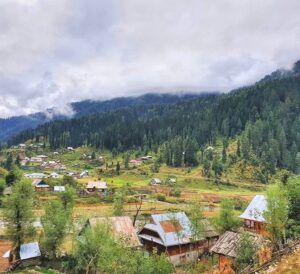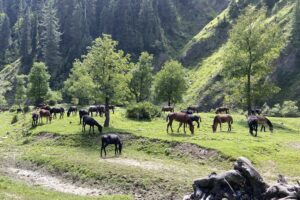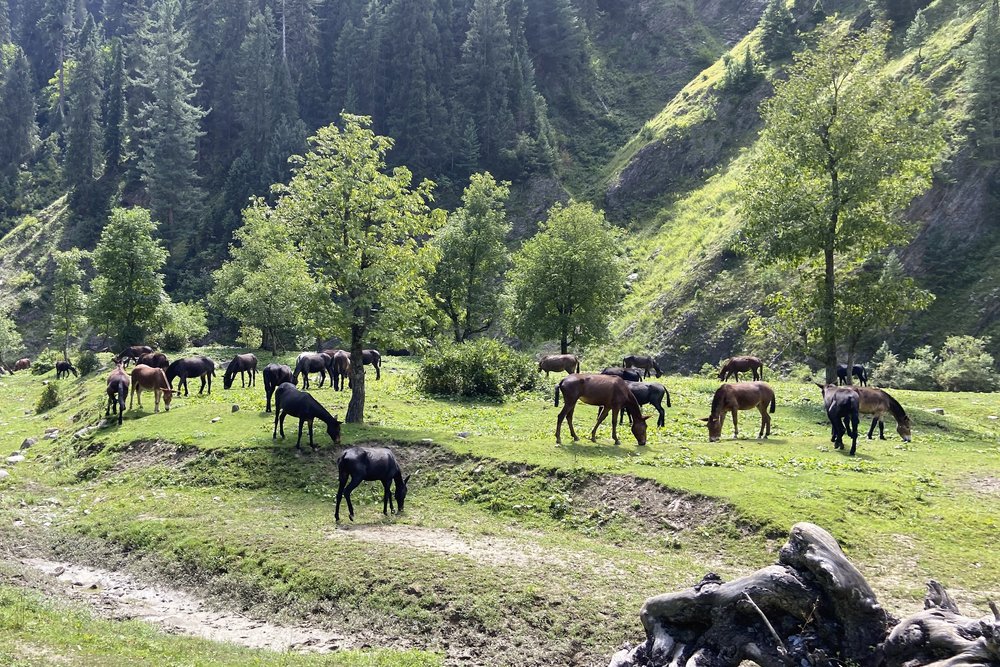Snowbound for half the year and wrapped in silence, Machhal is Kashmir’s best-kept secret — a land of legends, lakes, and endless green.

By Mool Raj
Tucked away in the remote and tranquil reaches of North Kashmir, beyond the towering Shamasabari mountain range and cloaked by the emerald canopy of the coniferous Lolab forests, lies the picturesque village of Machhal — also known by its alternate spellings Matchil or Macchil. This quaint hamlet, seemingly suspended in time, is more than just a scenic spot; it’s a living repository of culture, folklore, and natural splendor. Warm-hearted locals, known for their generous hospitality, welcome every visitor with open arms, often regaling them with vivid stories of the region’s mystical past, ancient traditions, and oral histories passed down through generations.
Located in the Kupwara district of Jammu and Kashmir, Machhal sits close to the Line of Control (LoC), imbuing it with both strategic importance and an air of mystique. Despite its proximity to geopolitical tension, the village is a haven of peace, offering travelers an escape into nature’s untouched beauty. Perched at a lofty altitude of 8,225 feet above sea level, the village is enveloped by dense Deodar forests, snow-covered mountain peaks, and softly undulating slopes. The glistening waters of the Nao Nar watershed flow into the Machhal Nar — a vital tributary of the Kishanganga River — enriching the terrain and adding to the village’s pristine charm.

Machhal’s isolation is as striking as its beauty. Each winter, the village remains cut off from the outside world for over six months due to relentless snowfall. During these harsh months, temperatures can plummet to a bone-chilling minus 15 degrees Celsius, while in summer, they rise to a comfortable 25 degrees Celsius. The region receives an average annual precipitation of 740.5 mm, mostly in the form of snow, further reinforcing its seclusion and ethereal allure.
Reaching Machhal is a journey in itself — one that calls to the adventurous spirit. Travelers must first traverse the captivating Lolab Valley before heading northwards toward the village of Kalaroos. This route winds through ancient Deodar forests and opens into the historical and mysterious Kalaroos caves, home to the fabled Satbaran monument — a structure with seven arched openings believed to date back to the Buddhist era in Kashmir. From Kalaroos, the route leads to Sarkuli village and then onwards through the thickly wooded Sarkuli Thiayan forest. Eventually, the landscape unveils the breathtaking Zamindar Gali (Z-Gali), perched at an elevation of 10,334 feet. From this lofty vantage point, a panoramic view of the Himalayas unfolds, including a distant glimpse of the towering Nanga Parbat, standing proud at 26,660 feet.
The Border Roads Organisation (BRO) plays a critical role in maintaining the accessibility of Machhal, often keeping the lifeline road operational during the less severe winter months — a challenging feat that underscores the strategic and logistical value of the region.
Beyond its spellbinding views, Machhal is home to a wealth of natural treasures — hidden alpine lakes, sparkling waterfalls, pristine meadows, and lush grazing lands cradled in the folds of surrounding mountains. The name “Machil” is believed to originate from the Dardic language, translating to “fish,” a nod to the abundance of fish once found in the village’s mountain streams. One popular local tale credits the name to a traveler named Mohammad Sultan Harray, who is said to have named various spots across the region during his explorations based on personal encounters and stories.

Agriculture remains the backbone of Machhal’s economy. The fertile valley sustains crops like corn, potatoes, and kidney beans. The local population demonstrates a remarkable blend of traditional knowledge and craftsmanship. While the men often engage in carpentry and other artisanal trades, the women play an equally crucial role, managing agricultural tasks and household responsibilities with resilience and grace.
Despite its extraordinary natural and cultural wealth, Machhal has remained largely off the radar for mainstream tourism, with most visitors to Kashmir gravitating toward urban centers and well-trodden destinations. Yet, the village and its surroundings offer immense potential for eco-tourism, adventure sports, and cultural exploration. Activities like white-water rafting and kayaking on the Machhal Nar, trekking through the untouched forests, angling in the crystal-clear streams, and camping under starlit skies could easily turn Machhal into a haven for nature lovers and thrill-seekers alike. Villages like Pushwari and Machhal could also benefit from homestay and bed-and-breakfast initiatives, which would not only support local livelihoods but also provide travelers with an authentic experience of Kashmiri village life.
Gastronomy in Machhal is another facet of its cultural richness. Visitors can savor a variety of local delicacies — from the soothing Noon Chai, a traditional salted pink tea brewed in a copper Samavar, to the aromatic green Kahwa served on festive occasions. The famed Wazwan, Kashmir’s multi-course culinary masterpiece rich in meat and spices, is an essential part of celebratory feasts and weddings, offering guests a deep taste of Kashmiri hospitality.
With its breathtaking vistas, cultural vibrancy, and untapped adventure tourism potential, Machhal stands as a hidden gem waiting to be discovered. As infrastructure improves and awareness grows, there lies an opportunity to spotlight this extraordinary village on both the national and international tourism maps — not only to share its beauty with the world but to also empower the local community through sustainable development and responsible tourism.
It is high time that Machhal stepped into the limelight — not just as a remote village nestled in the mountains, but as a beacon of what Kashmir has always symbolized: timeless beauty, resilience, and boundless charm.

Leave a Reply